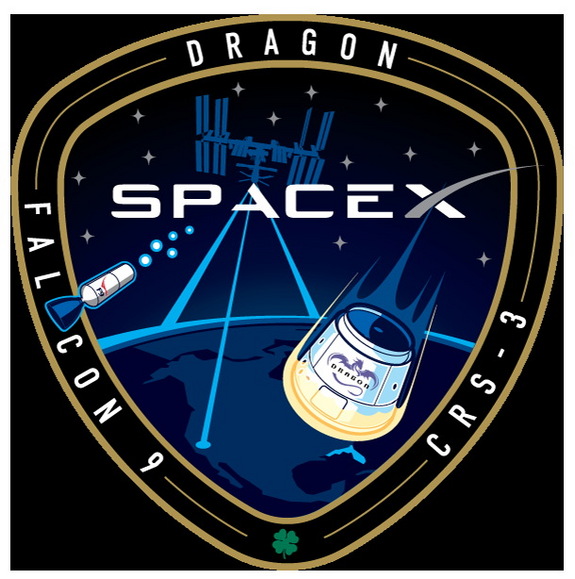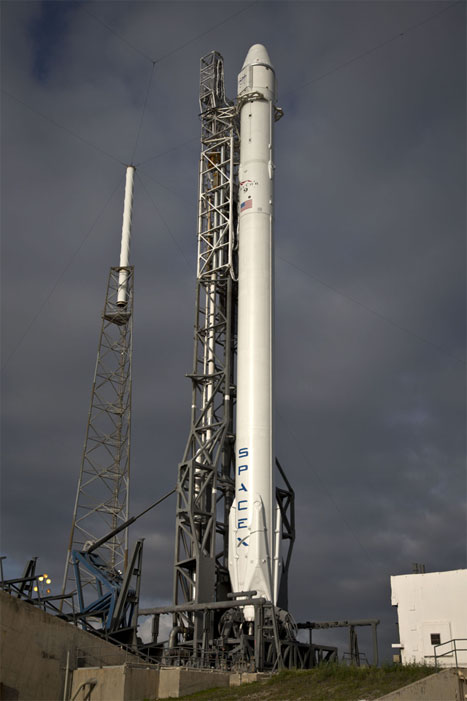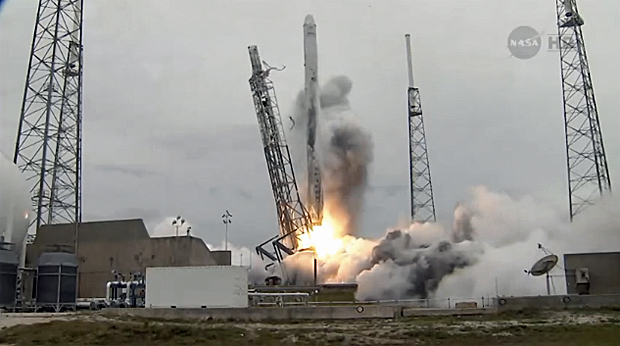.
14.04.2014

SpaceX Resupply Mission 'Go' For Monday Launch

SpaceX on track for Friday launch try
Sen—Space Exploration Technologies will make another attempt Friday, 18 April, to launch its Falcon 9 rocket and Dragon capsule on a resupply run to the International Space Station for NASA.
A launch attempt Monday from Cape Canaveral Air Force Station in Florida was canceled an hour before liftoff.
“Preflight checks detected that a helium valve in the stage separation pneumatic system was not holding the right pressure. This meant that the stage separation pistons would be reliant on a backup check valve,” SpaceX said in a statement issued Wednesday.
“No issue was detected with the backup valve and a flight would likely have been successful, but SpaceX policy is not to launch with any known anomalies,” the statement said.
The rocket has been returned to a horizontal position so technicians can replace the faulty valve.
The next launch try will be at 3:25 p.m. EDT/1925 GMT, but the weather could be a problem. Air Force meteorologists are predicting a 60 per cent chance of rain, and thunderstorms could force another delay.
The rocket will carry a Dragon capsule loaded with food, science experiments and gear for the space station, which flies about 250 miles (about 400 km) above Earth.
If the Falcon 9 launches as planned, the capsule would reach the station on Sunday.
As part of the flight, SpaceX plans to test technology it has been developing to recover and reuse its rockets.
The Falcon 9’s first stage carries extra fuel for two more burns after the upper-stage and Dragon capsule separate. The idea is to slow the rocket’s descent and position it for a soft touchdown on the ocean.
The booster also has four landing legs to help stabilize the vehicle.
Quelle: SEN
A Falcon 9 rocket that was supposed to launch Monday has been rescheduled for Friday afternoon.
The launch is now set for 3:25 p.m. Friday after a first-stage helium leak scrubbed the first attempt.
There is a 40 percent chance of favorable weather at launch time, with a chance of showers and thunderstorms that could violate launch constraints.
If there is a second scrub, SpaceX will attempt to launch Saturday, April 19 at 3:02 p.m.
NASA said this is an instantaneous launch time. That means it must happen for the rocket to launch and the Dragon capsule to catch up to the International Space Station within two days.
Despite a computer problem at the International Space Station last week, NASA gave the go-ahead over the weekend for SpaceX to launch its rocket later Monday.
The launch will also dictate when a contingency spacewalk will be performed to replace a failed multiplexer-demultiplexer aboard the ISS.
The rocket will deliver the Dragon capsule, with 2.4 tons of cargo for astronauts, to the space station.
Once there, astronauts there will unload the cargo, which includes research experiments, food and four high-definition cameras that will stream live video of Earth for online viewing.
The Falcon 9 rocket being used in this launch has been modified with new, 60-foot-long legs designed to help the rocket land back on Earth after launch, making the spacecraft reusable for future launches, like the space shuttles before it.
The plan is that after the Dragon capsule separates and heads for the ISS, the first stage of the rocket will make a soft splashdown in the Atlantic Ocean.
SpaceX said it wants to test the landing legs in the ocean first to improve precision, but eventually the private company wants to land the rocket near the launch pad. The company could save millions of dollars by reusing the rocket instead of having to build a new one for each launch.
SpaceX issued the following statement Wednesday morning:
NASA and SpaceX have confirmed Friday, April 18 for the next launch attempt for the Falcon 9 rocket to send the Dragon spacecraft on the company's third commercial resupply mission and fourth visit to the space station. Launch is targeted for 3:25 p.m. ET. The launch will be webcast live at www.spacex.com/webcast beginning at 2:45 p.m. ET.
A launch on Friday results in a rendezvous with the space station on Sunday, April 20 and a grapple at 7:14 a.m. ET.
During Monday’s launch attempt, preflight checks detected that a helium valve in the stage separation pneumatic system was not holding the right pressure. This meant that the stage separation pistons would be reliant on a backup check valve.
No issue was detected with the backup valve and a flight would likely have been successful, but SpaceX policy is not to launch with any known anomalies. We have brought the vehicle back to horizontal and are replacing the faulty valve, as well as inspecting the whole system for anything that may have contributed to the valve not working as designed.
Quelle: NEWS13
.
Update: 20.04.2014
.
SpaceX successfully launches The Dragon with supplies for International Space Station
The SpaceX company returned to orbit Friday, launching fresh supplies to the International Space Station after more than a month’s delay.
The Dragon cargo ship will reach the orbiting lab on Sunday — Easter morning. That pushes urgent spacewalking repairs to Wednesday; NASA wants a bad computer replaced before something else breaks.
This was the second launch attempt this week for SpaceX.
NASA’s commercial supplier was foiled by a leaky rocket valve Monday. The valve was replaced, and the company aimed for a Friday liftoff despite a dismal forecast. Storms cleared out of Cape Canaveral just in time for the mid-afternoon launch into overcast skies.
The unmanned cargo ship contains 2½ tons of station supplies, including material originally intended for the spacewalking repairs.
A critical backup computer failed outside the space station last Friday. The primary computer is working fine, but numerous systems would be seriously compromised if it broke, too. A double failure also would hinder visits by the Dragon and other vessels.
“It’s imperative that we maintain” backups for these external command-routing computer boxes, also called multiplexer-demultiplexers, or MDMs, said flight director Brian Smith said Friday. “Right now, we don’t have that.”
NASA decided late this week to use the gasket-like material already on board the space station for the repair, instead of waiting for the Dragon. Astronauts trimmed the thermal material Friday to fit the bottom of the replacement computer, and inserted a fresh circuit card.
Much-needed food is also aboard the Dragon, along with a new spacesuit and spacesuit replacement parts. NASA wants all these things at the space station as soon as possible.
The shipment is close to five weeks late. Initially set for mid-March, the launch was delayed by extra prepping, then damage to an Air Force radar and, finally on Monday, the rocket leak.
The space station’s six-man crew watched the launch via a live TV hookup; the outpost was soaring 260 miles above Turkey at the time of ignition. Video beamed down from Dragon showed the solar wings unfurling.
Earlier, as the countdown entered its final few hours, NASA’s space station program manager Mike Suffredini said an investigation continues into the reason for last summer’s spacesuit failure. The helmet worn by an Italian astronaut filled with water from the suit’s cooling system, and he nearly drowned during a spacewalk.
Routine U.S. spacewalks are on hold until engineers are certain what caused the water leak. The upcoming spacewalk by the two Americans on board is considered an exception because of its urgent nature; it will include no unnecessary tasks, just the 2½-hour computer swap.
NASA is paying the California-based SpaceX — Space Exploration Technologies Corp. — and Virginia’s Orbital Sciences Corp. to keep the orbiting lab well stocked. Russia, Japan and Europe also make periodic deliveries.
Unlike the other cargo carriers, the Dragon can bring items back for analysis. Among the science samples going up on the Dragon and slated to return with it in a month: 200 fruit flies and their expected progeny, and germs collected from stadiums and sports arenas, as well as such notables as America’s Liberty Bell and Sue, the T. rex fossil skeleton at Chicago’s Field Museum.
Scientists will study the hearts of the returning flies — as many as 3,000 are expected for the trip home, if the males and females do as they should. The germ samples, once back on Earth, will be compared with duplicate cultures on the ground.
Staying up there — for as long as the space station lives — will be new legs for NASA’s humanoid, Robonaut. The indoor robot has been in orbit for three years, but only from the waist up.
Quelle: SE


